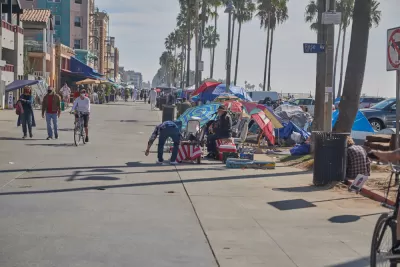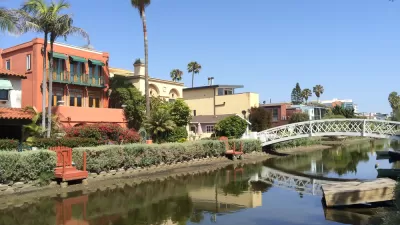The controversies about homelessness in what was once a beach community full of hippies and surfers has boiled over in response to a large proposed development of supportive housing on a surface parking lot owned by the city.

In June, Planetizen picked up news of an innovative new supportive housing project in Los Angeles. The project was designed by Eric Owen Moss Architects, a world renowned but locally based architecture firm, to bridge the Venice Canals and provide housing in one of the most affluent and historic parts of the city.
Fast forward to July, and Alissa Walker is reporting for Curbed about the less-than-favorable response for the project among local residents—in a neighborhood embroiled in an ongoing controversy involving City Council recalls and the county's controversial sheriff. A small group of local homeowners is planning to sue to stop the development, according to Walker, "hoping to contest the legality of a state law that allows affordable housing projects to skip environmental review."
According to Walker, opponents believe the project to be evidence of the city's plans to turn Venice into a "homeless containment zone." They would prefer a 43,000-square-foot, 600-space parking garage to be built on the lot instead.
Meanwhile, an estimated 2,000 people experiencing homelessness live on the streets of the neighborhood—the highest density homeless population outside of Skid Row adjacent to Downtown. The latest controversies about what to do about the large homeless population are detailed in the source article by Walker.
A separate article by Steven Sharp from May also provides details on the proposed project, including the latest renderings. Sharp first broke the news about the planned development in December 2018.
FULL STORY: Even a Starchitect’s Homeless Housing Project Won’t Sway Venice Beach NIMBYs

Study: Maui’s Plan to Convert Vacation Rentals to Long-Term Housing Could Cause Nearly $1 Billion Economic Loss
The plan would reduce visitor accommodation by 25,% resulting in 1,900 jobs lost.

North Texas Transit Leaders Tout Benefits of TOD for Growing Region
At a summit focused on transit-oriented development, policymakers discussed how North Texas’ expanded light rail system can serve as a tool for economic growth.

Why Should We Subsidize Public Transportation?
Many public transit agencies face financial stress due to rising costs, declining fare revenue, and declining subsidies. Transit advocates must provide a strong business case for increasing public transit funding.

How to Make US Trains Faster
Changes to boarding platforms and a switch to electric trains could improve U.S. passenger rail service without the added cost of high-speed rail.

Columbia’s Revitalized ‘Loop’ Is a Hub for Local Entrepreneurs
A focus on small businesses is helping a commercial corridor in Columbia, Missouri thrive.

Invasive Insect Threatens Minnesota’s Ash Forests
The Emerald Ash Borer is a rapidly spreading invasive pest threatening Minnesota’s ash trees, and homeowners are encouraged to plant diverse replacement species, avoid moving ash firewood, and monitor for signs of infestation.
Urban Design for Planners 1: Software Tools
This six-course series explores essential urban design concepts using open source software and equips planners with the tools they need to participate fully in the urban design process.
Planning for Universal Design
Learn the tools for implementing Universal Design in planning regulations.
City of Santa Clarita
Ascent Environmental
Institute for Housing and Urban Development Studies (IHS)
City of Grandview
Harvard GSD Executive Education
Toledo-Lucas County Plan Commissions
Salt Lake City
NYU Wagner Graduate School of Public Service





























